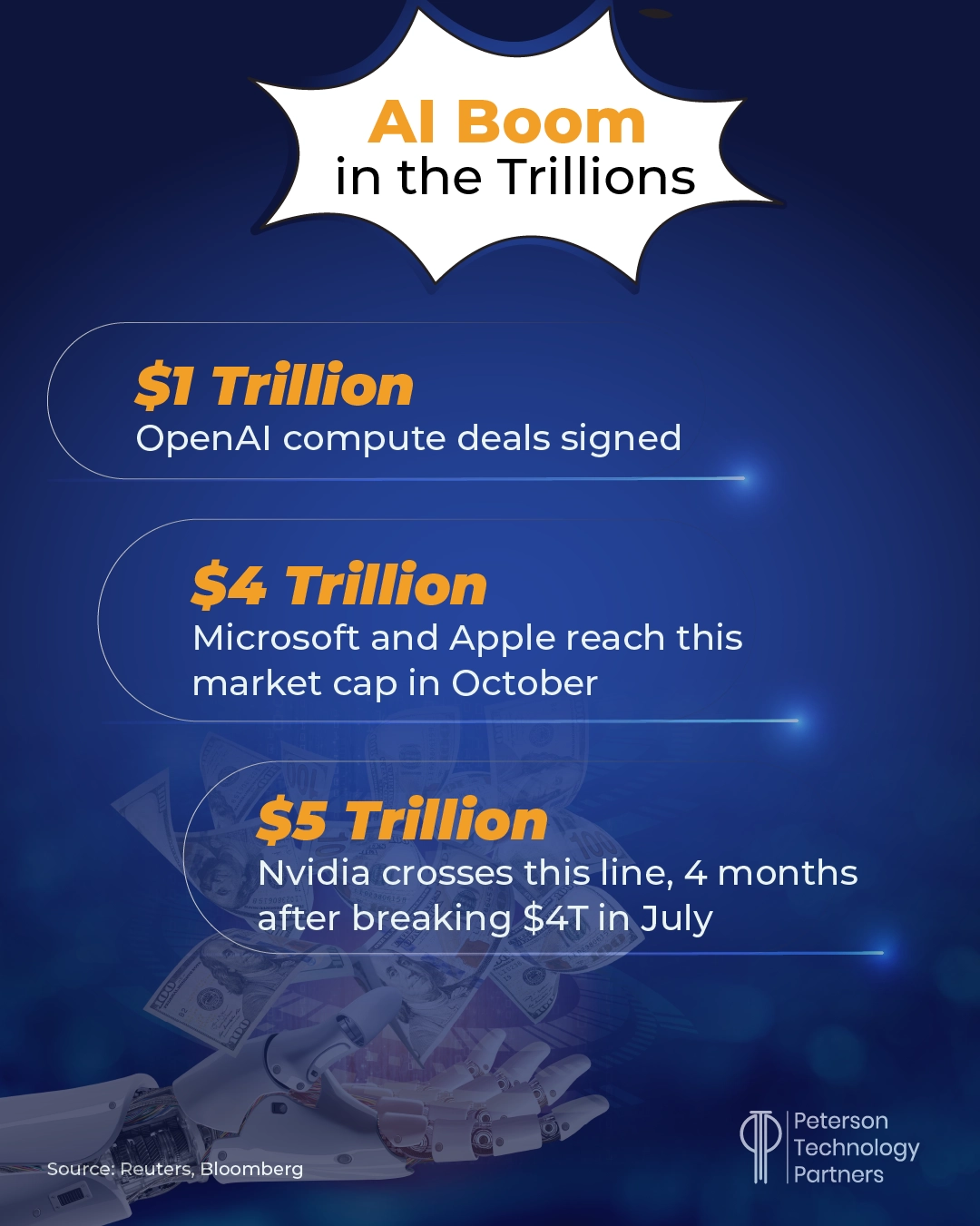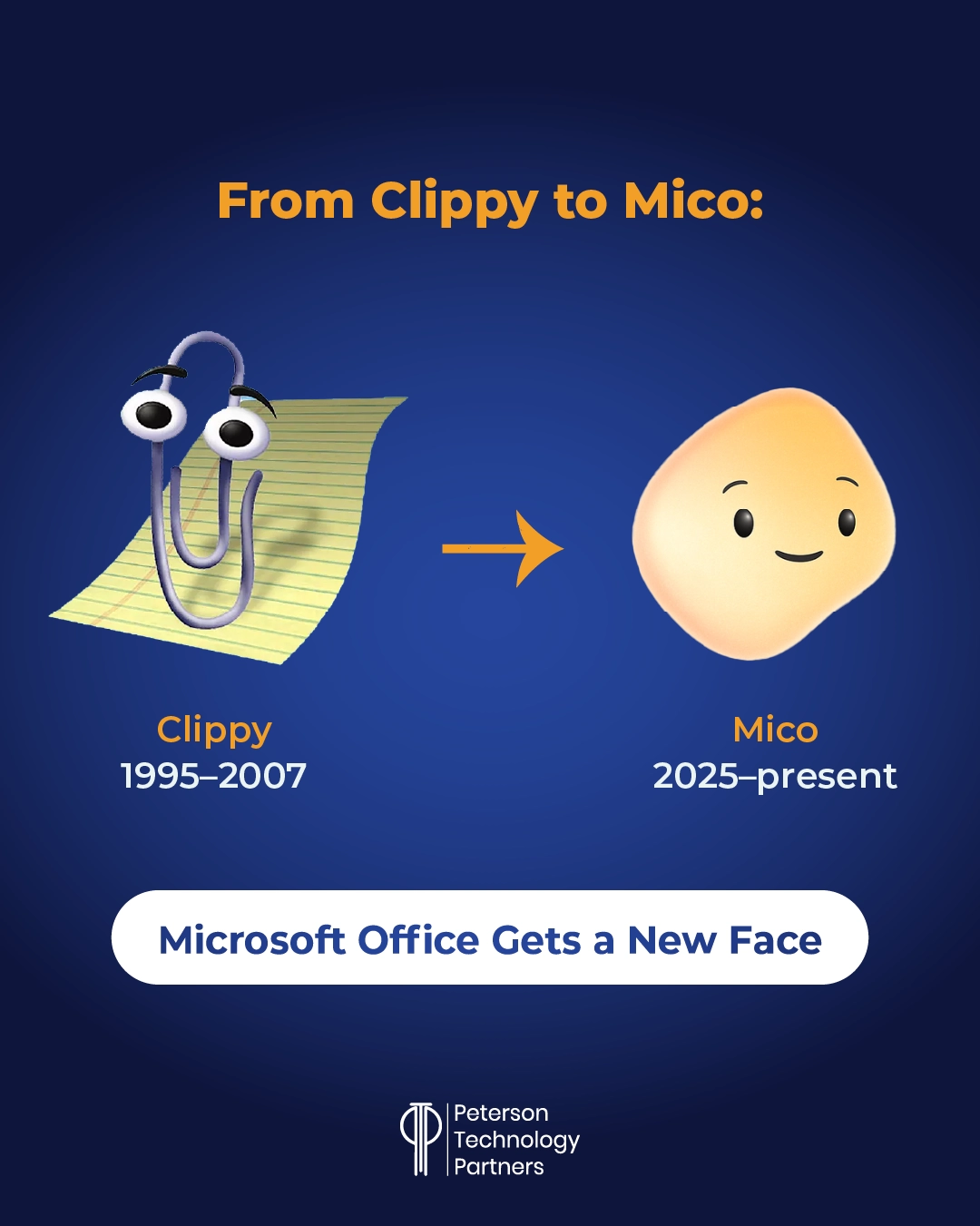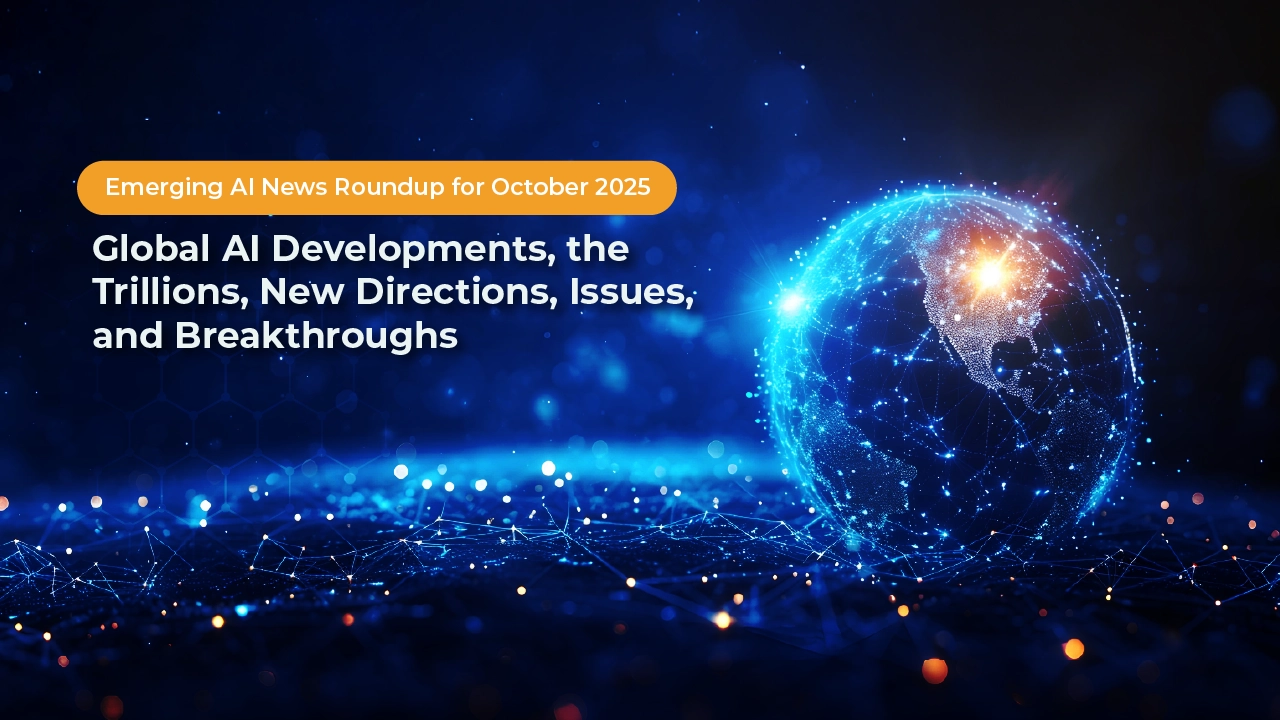October 2025 may be in the books, but we’re here today to help you catch up with all the emerging AI news and trends from what was a busy month in AI.
And as usual, there was far more than we had room to cover. We open with the continued surge in the AI-leading portion of Big Tech, with four of the big five announcing earnings at the end of the month. (The one that didn’t, Nvidia, still managed to steal the show—see below.)
In short, the AI boom continues in force, though Meta may still be lagging its peers in AI, despite continued revenue growth. Their investment costs, without a public cloud offering surging in demand (ala Amazon, Microsoft, and Google), concerned investors most. Still, they’re staying full-steam ahead on AI build-out.
Microsoft and Google both saw huge gains in their cloud business, with the former’s successful partnership with OpenAI continuing (tech access until 2032) and the latter’s Gemini app reaching 650 million monthly active users (up from 450 million last quarter, though still trailing ChatGPT’s 800 million).
Amazon’s AWS is by far the largest of the big cloud providers, and their revenue grew as well, with Amazon announcing more spending than anyone else in this arena. CEO Andy Jassy added that they have continued demand as fast as they can build capacity.
All told, the news sent the big AI surging higher than ever, with several of the companies reaching multiple-trillion-dollar marks in October.

We start with AI technology updates, look at the continued chip power and Chinese AI breakthroughs, and revisit hiring updates and continued bubble talk.
And if you need to catch up on any of the AI news to date, you can check out our prior, bi-monthly roundups for 2025 below:
Spotlighting Some of the Latest AI Innovations
FDE stands for several things, but in AI circles it’s increasingly being used for “forward-deployed engineers.”
Developed initially by Palantir and now in use at companies like Salesforce, ServiceNow, Snowflake, Microsoft, Oracle, OpenAI, Anthropic, and Sierra, these software engineers are specialists who work closely with customers, bringing software, platform engineering and solutions architect talents all to bear on whatever mix of software and hardware products that company has in use.
ServiceNow calls theirs “AI black belts,” and they’re now being used to help get AI going successfully at businesses, and fast.
While humans are getting better at implementation, AI agents, despite thriving in well-defined, limited spaces, are still struggling to manage tasks as complete solutions, at least over freelance tasks. The new Remote Labor Index benchmark developed by Scale AI and the Center for AI Safety (CAIS) shows just how much.
Given simulated freelance work tasks to achieve, the leading AI agents could manage less than 3% successfully (this equated to earning around $1,810 of a possible $143,991).
Chinese startup Manus did best (2.5% automation rate), followed by Grok 4 and Sonnet 4.5.
Faring better? Conversational AI, which continues to come along rapidly. Salesforce’s CEO Marc Benioff said in October that his company is saving around $100 million a year using AI in its customer service operations.
Another example? Adobe’s Corrective AI, previewed for Wired ahead of Adobe’s MAX Sneaks showcase. This product can alter the audio of a speaker’s voice to completely change the emotions being used, in seconds. This means you can take a voiceover from angry to monotone to a whisper at a toggle.
Global construction equipment powerhouse Caterpillar is one example of a company you may not associate with ongoing data center needs. But their generators and turbines are hard at work in the space, with their once-trailing energy division now becoming the company’s fastest-growing unit.
We’ve covered previously how aggressively Walmart is moving into AI, and this month they announced a partnership with OpenAI that will allow customers to shop directly in ChatGPT using Instant Checkout, and to use ChatGPT in the search bar of the Walmart and Sam Club websites.
On Halloween, Walmart also announced the addition of AI-powered shopping tools to their existing app, and an upgrade to their own chatbot, Sparky, enabling it to create curated lists for party planning.
This is all fine and well, but what about coffee?
Starbucks CEO Brian Niccol said don’t expect robots making your drinks at their cafes anytime soon, but they have rolled out their own AI barista assistant, Green Dot, for work behind the counter. The company is also claiming big boosts from AI use in coding.
ChatGPT as Operating System
Many researchers and AI pioneers have talked about AI replacing entire tech stacks, but OpenAI appears to be starting with your operating system. In October, the company unveiled increased capability to run third-party apps within its chatbot, with an SDK that uses open standards, now available for developers.
Their demo included Spotify, Canva, and Zillow, and as mentioned above, Walmart has embraced this capacity to let customers shop for their products from within the chatbot.
This is no doubt just one of several moves tied up with OpenAI’s restructuring news, aimed at increasing its profits. They also announced a deal with PayPal to work on deploying a ChatGPT wallet in 2026 and added another big cross-AI contract in recent days, this time with Amazon on a $38 billion infrastructure deal.
This sees OpenAI using AWS data centers immediately, though still only with Nvidia chips for the time being.
Browser Wars, Bankers, and Consultants on Hire
Speaking of integrations, successful AI search startup Perplexity rolled out its AI-powered web browser, Comet, earlier this year. In October they made it free, coinciding with the release of OpenAI’s browser, Atlas.
The ChatGPT version is based on the open-source Chromium, which is developed and maintained by Google. It joins others like Microsoft’s Edge, Opera One, Dia, and Brave’s Leo, and while these all boast more direct AI-integration (and access to agent functionality in most cases), they’ve also come under fire in recent weeks for security vulnerabilities including prompt injection.
As Mozilla’s senior principal engineer Brian Grinstead told ZDNET, this group of agentic browsers “do not have the ability to separate trusted content coming from the user and untrusted content coming from web pages.”
Bloomberg reported in October on a pair of moves aimed to improve AI’s work capacity: one by OpenAI codenamed Mercury that involves paying former investment bankers (from JPMorgan Chase, Morgan Stanley, and Goldman Sachs) $150 an hour to teach AIs to streamline entry-level tasks in their field, with another codenamed Argentum focused on ex-consultants (from firms like McKinsey, Bain, and Boston Consulting Group).
GM’s Hands-Free Driving AI, AI Staging, and Workslop vs Art Slop
Other integrations and announcements in the innovations arena:
- GM is aiming to “transform the car from a mode of transportation into an intelligent assistant” between now and 2028, per CEO Mary Barra. This includes pulling Google Gemini technology into its cars, which will enable driver assistance and hands-free technology.
- AutoReel is a startup app that lets realtors make videos from images, with the company claiming 500 to 1,000 new listing videos being made daily in the US, India, and New Zealand. While digital staging isn’t new, AI virtual staging for real estate is, and it’s increasingly seeing use in ways both good and bad. Among the latter: clients complaining to Slate’s Tanya Chen about slop that incorrectly renders home dimensions, adds impossible aspects, or goes overboard in perfecting the look.
- Researchers from BetterUp Labs and Stanford’s Social Media Lab are credited with coining the term workslop (also in a recent Harvard Business Review). This refers to AI-generated content that only looks good while failing to meaningfully advance its given task. They find workslop can actually shift the burden of work from the sender to the receiver, who has to correct or redo work that only looks good. Some 40% of surveyed workers said they’d received workslop over the past month.
- And while workslop may be proliferating, so too is AI art (artslop?) entering the mainstream. MIT Technology Review reported in October on art by Henry Daubrez that recently sold at Sotheby’s for $24,000. You can view it and decide for yourself—slop or art? Or both? Daubrez is now a filmmaker in residence at Google.
The Superintelligence Ban Debate
Most AI experts agree we’re nowhere near AGI, let alone superintelligence.
But concerns around the safety of the pursuit made the news in October, as a large number of high-profile individuals across industries, nations, and the political spectrum all signed onto a Statement on Superintelligence from the Future of Life organization.
At the time of this writing, it’s reached 68,443 signatures, including, from tech, Apple co-founder Steve Wozniak, two of the “godfathers of AI” in Yoshua Bengio and Geoffrey Hinton, and leading AI researchers like UC Berkeley’s Stuart Russell.
The petition calls for the outlawing of superintelligence development until there is both broad scientific consensus on safety and control and strong public support.
Research from the organization found that just 5% of US adults support superintelligence development under current conditions and levels of transparency.
And while it may not be superintelligent, the Financial Times reported on a growing form of fraud: creating fake receipts with GenAI. These are turning up in numerous ways, including as deceptive or falsified expenses on expense reports.
According to software provider AppZen, 14% of falsified documents submitted in September were made via AI (compared with zero last year).
And as with faked term papers in schools around the world, companies are also fighting back with AI detection tools.
China AI Developments from DeepSeek to Duobao
We touched above on the autonomous AI agent Manus, which is standing alongside other top AI agents in several agentic benchmarks. But this just one of several Chinese AI products keeping pace with outputs from the big US AI companies.
This includes:
- TikTok parent company ByteDance’s Duobao chatbot has become one of the world’s most popular chatbots, bypassing offerings from rival DeepSeek. And while it’s still well behind ChatGPT and Gemini with its 157 million monthly active users, the app in August became the fourth-most popular GenAI app worldwide. The company also has an overseas version, called Cici.
- DeepSeek is continuing to make news with its own innovations, including an optical character recognition (OCR) model released in late October that extracts text from an image and converts it to machine-readable words (similar scanner apps). Why does this matter to AI? This approach can improve how AI models recall information, reducing necessary computing power significantly. This method is detailed by company research and in the MIT Technology Review, enabling the packing of information into images instead of storing as tokens.
- Huawei is part of the WorldGrow project, an AI system that can create real-time (and endless) 3D environments by putting together rooms and hallways. At a time when world models are seeing increased investment from companies, this model’s ability to endlessly create new 3D spaces is drawing attention.
- In the political sphere, the White House announced this week that China is dropping its investigation into US chip companies (like Nvidia and Qualcomm) as part of the larger trade deal between the two countries.
More on AI Hiring and Layoffs in 2025
The period of holding onto labor for fear of getting replacements may be at an end, per reporting by Bloomberg and the Wall Street Journal. Layoffs in 2025 have already outpaced every full, non-COVID year since 2009, and the total now includes some 600 from Meta’s AI Superintelligence labs.
Is AI to blame? As we reported last time out, some researchers believe we can’t yet know for sure.
But the cutting of 14,000 corporate jobs at Amazon, announced on their blog in October, has been attributed to AI in part. The New York Times also reported on Amazon’s plans over the next eight years to potentially cut 600,000 more positions due to robotics innovations.
In the process of hiring itself, there’s an ongoing AI arms race between candidates and recruiters which is seeing a spike in applications (+45% overall), and resumes with AI-generated content (62%, both per StaffingHub), going up against AI-driven filtering (used by 90% of employers per the World Economic Forum) and progressive recruiting technologies like AI-run interviews.
The New York Times reported in October on additional new tricks in this arena, like prompt injection commands hidden on resumes aimed at promoting candidates. The US’s largest staffing firm, ManpowerGroup, now finds hidden text on roughly 10% of all resumes they scan with AI.
Nvidia’s AI News Roundup for October 2025
We covered OpenAI’s reorganization and new offerings and the continued investments (and revenue) of big AI companies above.
With Microsoft thriving in its cloud business and Copilot offerings and taking around a 27% stake in the now–for-profit OpenAI (including securing use of their tech until 2032), they felt they could afford another big risk: taking another go at Clippy.

This time, the face of Microsoft Office is an AI character named Mico (pronounced MEE’koh), whose face will change based on emotions.
Currently only rolled out in the US, it can be easily turned off, unlike its predecessor, the infamous Clippit (aka Clippy).
AI Stocks and Investments Continue to Power the Market
Goldman Sachs estimated that the hyperscalers in this space (Microsoft, Meta, Alphabet, and Amazon) now account for more than a quarter of all the capital expenditure for the entire S&P 500.
Amid the incredible scale of deals passing between the major companies and their importance to the economy overall, talk of the AI bubble continued to rage throughout October.
Those in favor of calling this a bubble (like Amazon’s Jeff Bezos, at Italian Tech Week), point to a hype cycle leading to the funding of “every experiment” including both the “good ideas and the bad ideas,” where it can be hard to tell between the two. But Bezos also stressed AI’s importance, saying it will impact every company in the world, boosting quality and productivity at once.
Numerous financial analysts are coming down on the other side as well, like Cantor Fitzgerald’s CJ Muse, who published a note detailing that we’re still in the early phase of a “multi-trillion AI infrastructure build-out” where the demand we can measure is limited currently by hyperscalers and what they can see.
He called it “not a bubble,” but instead just “the early innings of this investment cycle.”
Chip Demand Shows No Signs of Letting up
TSMC saw demand for its AI chips continue to surge, and we mentioned above that Nvidia has now reached the $5 trillion milestone.
Their latest spike in value was powered in part by a flurry of announcements from DC at their GTC tech conference. Their news included:
- A deal with the US Department of Energy for seven new supercomputers (including one that’s using a reported 10,000 Blackwell GPUs)
- Work with Uber on self-driving cars
- A robotaxi venture with Stellantis and Foxconn
- Additional self-driving tech collaborations with Lucid and Mercedes-Benz
- A sale of GPUs to multinational pharmaceutical company Eli Lilly
- Deal with Nokia to develop new 6G cellular tech
- Additional 6G wireless buildouts with Cisco and T-Mobile
- New partnerships with Palantir and Oracle
- Robotics initiatives with Amazon, Caterpillar, and Belden
- New open-source systems architecture (NVQLink) for quantum supercomputers
- New deals for accelerator chips for three of South Korea’s biggest companies: Samsung, Hyundai, and SK Group
- The expectation of $500 billion in GPU sales through the end of next year
In the chips arena overall, Wired’s Will Knight profiled Extropic, a startup whose probabilistic bits-handling chips offers a radically different approach to AI. Their TSUs (thermodynamic sampling units) differ from GPUs or CPUs and could be both far cheaper and thousands of times more energy efficient when scaled.
Meanwhile, Intel has also seen its own value rise many times over at the tail end of this year, paying off investments from the US government and Nvidia, among others. This is due in part to global demand for its CPUs, which are needed in data centers alongside the more heavily discussed GPUs.
In early October, Intel announced a new fabrication plant in Arizona called Fab 52, which is now operational and will begin shipping data center products early next year.
Conclusion
PTP’s Founder and CEO wrote about mechanistic interpretability, or MI, in a recent Substack, and you can check that out for more on the research seeking to understand why AI systems do what they do.
Other research in this arena in October showed how just 250 poisoned documents can cause even a 13 billion parameter LLM to collapse (from the UK AI Security Institute, Alan Turing Institute, and Anthropic), and that LLMs can suffer from brain rot from too much social media, just like the rest of us (in Nature, from Purdue, UT Austin, and Texas A&M).
Above we wrote about FDE and AI black belts. If your company is in need of AI assistance, whether it’s onsite or off—nearshore, onshore, or offshore—contact PTP. We’re an AI-first recruiting and consulting firm, and we love helping companies get real value from AI.
That’s all for this edition of our monthly AI roundup!
References
Applied AI: How Microsoft Escaped the AI Margin Squeeze; An FDE Boom, The Information: Applied AI
What are Forward Deployed Engineers, and why are they so in demand?, The Pragmatic Engineer
Why Companies Are No Longer Hanging On to Employees, The Wall Street Journal
Recruiters Use A.I. to Scan Résumés. Applicants Are Trying to Trick It., The New York Times
Nvidia stock nears $5 trillion market cap after slew of updates at GTC event, Walmart announces new AI shopping tools ahead of holiday season, building on OpenAI partnership, Starbucks’ AI barista is changing how your coffee gets made, and Nvidia stock climbs to record amid reported UAE export approval, price target raise: ‘This is not a bubble’, Yahoo Finance
AI Agents Are Terrible Freelance Workers, Extropic Aims to Disrupt the Data Center Bonanza, Adobe’s ‘Corrective AI’ Can Change the Emotions of a Voice-Over, Trump’s Investment in Intel Is Paying Off, How ByteDance Made China’s Most Popular AI Chatbot, Wired
OpenAI Gives Microsoft 27% Stake, Completes For-Profit Shift, Ex-McKinsey Consultants Are Training AI Models to Replace Them, Bloomberg
Are AI browsers worth the security risk? Why experts are worried, ZDNET
GM plans to launch eyes-off driving, Google AI and other new in-vehicle tech by 2028, CNBC
Beware co-workers who produce AI-generated ‘workslop’, TechCrunch
‘Do not trust your eyes’: AI generates surge in expense fraud, Financial Times
DeepSeek may have found a new way to improve AI’s ability to remember, MIT Technology Review





